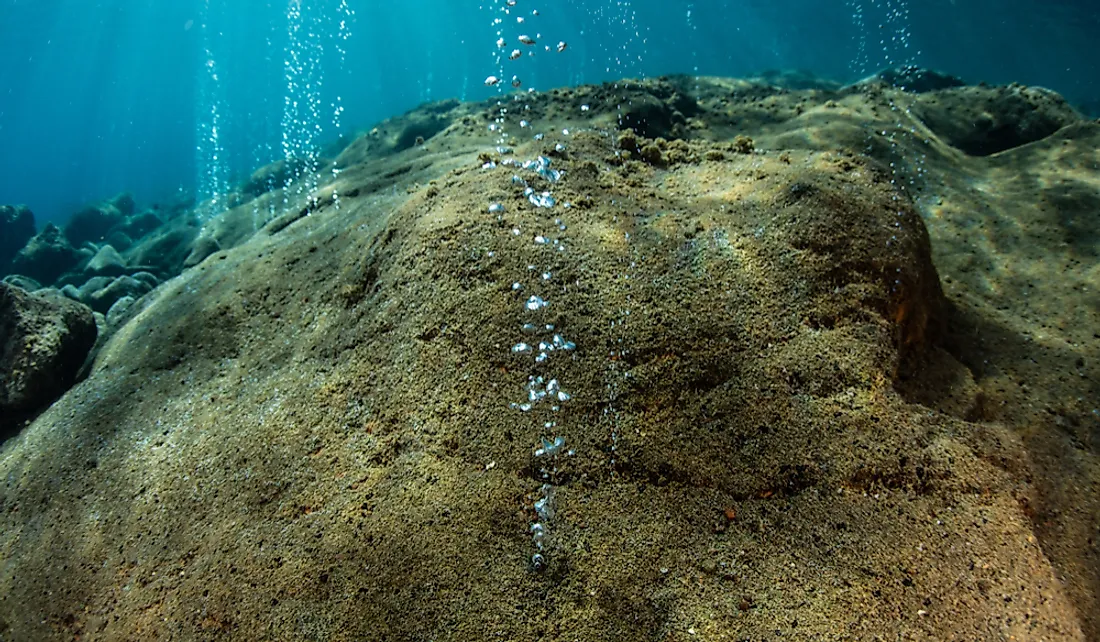Are There More Volcanoes On Land Or Underwater?

Volcanic eruptions pose serious threats not only to human life but also in relation to possible widespread property damage as well as the destruction of the surrounding environment. Interestingly, however, there are more volcanoes to be found underwater than there are on the surface of the Earth. The majority of the world’s volcanoes are located in the middle of the ocean in a mountainous chain which runs around the planet and covers a length of over 30,000 miles. These massive volcanoes can reach heights of over 18,000 feet.
Formation of Volcanoes
Volcanos are the result of the continuous separation of the tectonic plates covering the Earth’s outer shell or lithosphere. This layer is broken up into various plates of various sizes (seven major and 152 smaller ones). The plates which make up the Earth’s outer crust float on a layer of hot fluid magma, partially liquefied rock, and gas. As the tectonic plates drift apart then bump together magma builds up underneath the surface until it comes exploding out of the vent of the volcano. Land volcanoes are the specific result of tectonic plates ramming up against continents. This geologic activity is particularly evident in places such as Japan and the US state of California.
Land Volcanoes
According to the U.S. Geological Survey, there are approximately 1,500 land volcanoes located throughout the world which have the potential to possibly erupt sometime in the future. Of these, 169 are found in the United States. Globally, countries with the most potentially active volcanoes are Japan, Indonesia, and the United States. The majority of American volcanoes are located in the Alaska Peninsula, Aleutian and Hawaiian Islands, as well as the Cascade Range of the Pacific Northwest. The largest active volcano in the world, Mauna Loa, can be found in the state of Hawaii. This massive geologic structure not only descends three miles under the Pacific Ocean but due to the significant weight of the volcano pressing down on the seafloor it sinks down another five miles. Above sea level, Mauna Loa rises to a height of more than 2.5 miles. In total from its underwater base to its summit, the world’s largest volcano spans a total of 10.5 miles.
Ring Of Fire
The greatest number of underwater volcanoes are part of the so-called Ring of Fire. Located in a horseshoe-shaped basin under the Pacific Ocean this area stretches for 25,000 miles and includes an abundance of volcanic arcs and belts along with deep oceanic trenches. In total this one geographical area is home to 452 volcanoes; accounting for about 75% of all the active as well dormant volcanoes found on the entire planet. Also known as the circum-Pacific belt, the Ring of Fire accounts for some 90% of the earthquakes which occur on Earth. Astonishingly approximately 81% of the deadliest earthquakes in history have occurred somewhere along the Ring of Fire.
World’s Biggest Volcanoes
Besides Hawaii’s Mauna Loa, the Earth is home to many colossal volcanoes both on land and underwater.
Tamu Massif
Tamu Massif, for example, is a shield volcano that occupies a volume of 600,000 cubic miles on the floor of the Pacific Ocean. This mighty structure, which is located approximately a thousand miles from Japan, wasn’t technically discovered until 2013. Prior to that time, it was thought to have been part of a plateau known as the Shatsky Rise. The volcano’s round shaped dome has been calculated to measure 280 by 400 miles. Its dome-like opening can be found 6,500 feet below the surface of the Pacific Ocean while its base is estimated to lie four miles deeper. Tamu Massif is classified as an extinct volcano and hasn’t erupted in 144 million years. In a 2013 report published in National Geographic, Tamu Massif was revealed to be comparable in size to the US state of New Mexico as well as the entire British Isles region.
Kilimanjaro
Kilimanjaro, in Africa, is another impressive volcano which is actually comprised of three volcanic structures. Occupying a volume of 1,150 cubic miles this well-known geologic structure towers over the countries of Kenya and Tanzania. The last time Kilimanjaro experienced a large scale eruption was 360,000 years ago.
Ichinsky Volcano
Russia is another country known as a hotbed for volcanic activity. The northern Ichinsky volcano is located on Russia's Kamchatka Peninsula which is an area characterized by its isolated, rough, and rugged terrain. This stratovolcano (otherwise known as a composite or conical volcano) has been deemed to be active even though it hasn’t erupted since 1740. Inchinsk occupies a volume of 110 cubic miles amidst a stark landscape occupied by with glaciers, ash, mudflows, and other volcanic material previously spewed from out of this fearsome northern volcano.
Sierra Negra
The Sierra Negra, located at the southeastern end of Isabela Island, is classified as a shield volcano and can be found in the Galapagos Islands which is an area that owes its very existence to volcanic activity. The Sierra Negra is an active volcano which measures some 140 cubic miles in terms of volume and rises to a height of 1124m. Scientists have estimated the Sierra Negra volcano to be 535,000 years old with its most recent eruption taking place June 27, 2018.











